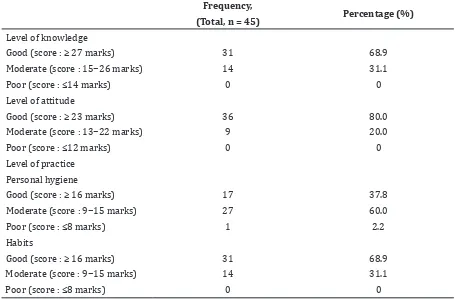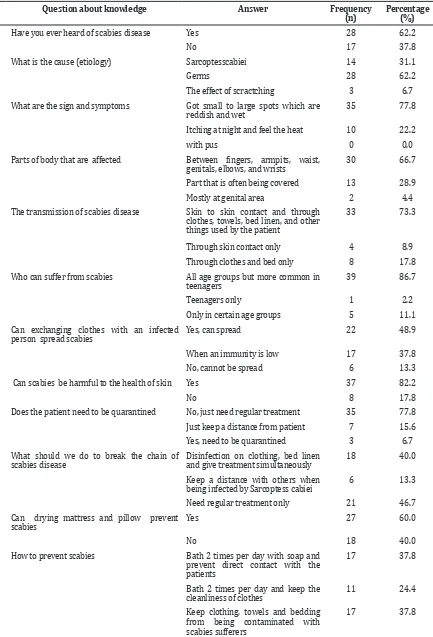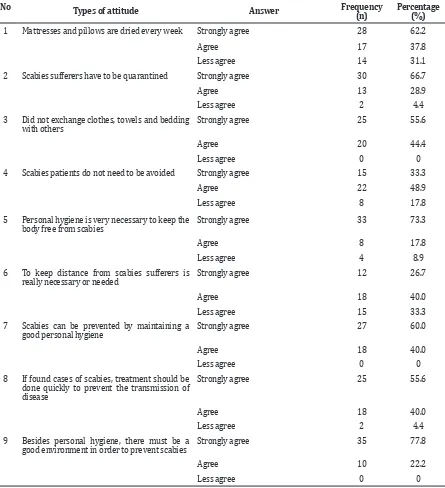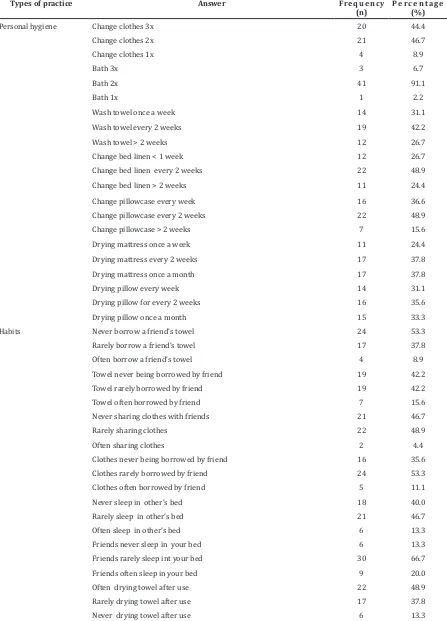A Study on Knowledge, Attitude and Practice in Preventing
Transmission of Scabies in Pesantren Darul Fatwa, Jatinangor
Mahirah Binti Mohd Yusof1, Silvita Fitri R2, Yunita Damopolii3
1Faculty of Medicine, Universitas Padjadjaran, 2Department of Parasitology, Faculty of Medicine, Universitas Padjadjaran, 3Department of Dermatology and Venereology, Faculty of Medicine,
Universitas Padjadjaran/Dr. Hasan Sadikin General Hospital Bandung
Abstract
Background: Scabies is caused by infestation and sensitization of Sarcoptess cabiei and is an endemic in tropical and subtropical regions around the world. Several factors in the disease transmission are overcrowded living conditions, poor personal hygiene, unhealthy behaviors and population density. Pesantren is a spesific name for an educational Islamic institution in Indonesia and which w could be one of the risk factors of the transmission the disease. Most of the students (santri) are staying at the institution for a long time. The objective of this study was to know the level of knowledge, attitude and practice of santri in preventing scabies.
Methods: A descriptive study was conducted on 45 santri in Pesantren Darul Fatwa in Jatinangor during September–December 2012. A questionnaire was set up consisting of questions about age, sex, basic knowledge, attitude, and practice of preventing the transmission of scabies. Data were analyzed using frequency distribution.
Results: The level of knowledge and attitude of the respondents to prevent the transmission of scabies were good, meanwhile the level of practice was moderate. There were still questions that could not be answer by the respondents those were the etiology (31.1%), the cut off chain of transmission (40%), and how to prevent scabies (37.8%). Not washing the towel, changing the bed linen and pillow case every 2 weeks were the less good practice performed by the respondents.
Conclusions: The knowledge and attitude towards the prevention of transmission of scabies are good while the practices are moderate. A further study with more sample size should be carried out including enviromental assessment.
Key words: Attitude, knowledge, practice, scabies
Correspondence: Mahirah Binti Mohd Yusof, Faculty of Medicine, Universitas Padjadjaran, Jalan Raya
Bandung-Sumedang Km.21, Jatinangor, Bandung-Sumedang, Indonesia, Phone: +62 838 2016 4451 Email: [email protected]
Introduction
Scabies is a skin disease caused by infestation and sensitization to Sarcoptess cabiei mites and is an endemic in tropical and subtropical areas such as Egypt, Central and South America, Africa, India, and Southeast Asia.1 According to a World Health Organization (WHO) report scabies has a potential to bring about an epidemic condition in an area. This condition was found among others in Bangladesh where children under-6-year-old were affected within a period of 12 months , India (13%), Australian Aboriginal communities (50%) and in Sierra Leone (86%).2 Incidence in Indonesia was 4.60–12.95% in 2002 and was in the third-ranking of the other 12 common diseases.3 Scabies occurs mostly to very young, and
132 AMJ March, 2015
and environmental hygiene, unhealthy behavior and population density.4 The lack of knowledge about personal hygiene affects the increased number of incidence of scabies 15% due to rarely taking a shower, and 42% due to frequently sharing clothes with friends.5
According to Bloom’s theory in Notoatmodjo6, behavior includes knowledge, attitude and practice of an individual. Knowledge is a cognitive domain and is the result of knowing people’s sense of any particular object which is important for the formation of a person’s actions (overt behavior). Meanwhile, attitude is a readiness or willingness to act, and not an implementation of a particular motive.
Pesantren or Pondok Pesantren is a spesific name for an educational Islamic institution in Indonesia, and throughout the Malay region7. This institution is not only the center for Islamic studies but also for the spreading of Islam.7 During the day, students attend formal school like any other students outside of pesantren, and in the late afternoon and evening they have to attend religious rituals followed by religious studies and group studies to complete their education. Most of the students stay at the institution for a long time according to the regulation of the pesantren.
Due to the unique epidemiology of scabies, pesantren could be one of the risk factors for the transmission of the disease. A study in Kendal8 found that the prevalence was 27%. Another study by Ma’rufi9 in Lamongan, East Java, found the prevalence of scabies among students was high i.e. 64,20%. There are many factors contributing to this high prevalence, among others are the lack of knowledge, attitude and practice among the santri (pesantren students). This study was conducted to know the level of knowledge, attitude and practice of santri in pondok pesantren Darul Fatwa in Jatinangor in efforts to prevent scabies.
Methods
This study was conducted on 45 santri who studied and lived in Pesntren Darul Fatwa in Jatinangor for at least 2 months, during the period September–December 2012. The exclusion criteria included santri who couldnot complete the full process of data acquisition by a variety of reasons. A questionnaire was set up consisting of questions about age, sex, basic knowledge of scabies such as clinical etiology, symptoms,
risk factors, prevention, treatment, attitude, and practice of santri towards scabies in order to prevent scabies in pondok pesantren. This questionnaire was tested to 30 respondents and Cronbach’s Alpha was performed . The test showed that coefficient reliability was 0.744. The level of knowledge, attitude, and practice was measured using a scoring system as follows: Good : score is ≥75%, Moderate : score is 40%−74%, and Poor : when the score is <40%.10 . Data were analyzed using frequency distribution.
Results
Male respondents with a mean age of 15 years old comprised the highest percentage of the respondents (55.6%).
The level of knowledge of the respondents in the effort to prevent scabies was generally good (68.9%), the level of attitude was good (80.0%), and the level of practice based on personal hygiene was moderate (60%) (Table 1).
In general, the majority of respondents could answer all the questions about scabies correctly except for three questions, those were the etiology of scabies (31.1%), what to do to break the transmission of scabies (40%), and how to prevent scabies (37.8%)
According to Table 3, 28 respondents (62.2%) answer agree to dry mattress and pillows every week and it showed that the majority of them strongly agree that they should be aware of scabies even though it does not lead to death which comprised about 66.7% (30 respondents). However, 4 respondents (8.9%) showed less agree to the statement that good personal hygiene could keep the body free from scabies.
Majority of the respondents had a good practice of personal hygiene (Table 4). For the questions of how many times the respondents change clothes during the day, mostly answered 2 or 3 times per day with 46.7% and 44.4% respectively. Unfortunately, the highest percentage of practices to spread the disease was washing the towel, changing the bed linen and pillow case every 2 weeks. While there, were still 46.7% of respondents whopractised bed sharing.
Discussions
Table 1 Distribution of respondents based on level of knowledge & attitude
Frequency,
Percentage (%) (Total, n = 45)
Level of knowledge
Good (score : ≥ 27 marks) 31 68.9
Moderate (score : 15−26 marks) 14 31.1
Poor (score : ≤14 marks) 0 0
Level of attitude
Good (score : ≥ 23 marks) 36 80.0
Moderate (score : 13−22 marks) 9 20.0
Poor (score : ≤12 marks) 0 0
Level of practice Personal hygiene
Good (score : ≥ 16 marks) 17 37.8
Moderate (score : 9−15 marks) 27 60.0
Poor (score : ≤8 marks) 1 2.2
Habits
Good (score : ≥ 16 marks) 31 68.9
Moderate (score : 9−15 marks) 14 31.1
Poor (score : ≤8 marks) 0 0
6 levels, where each level is a sequence of processes from the lowest to the highest level. The lowest level is knowing which is is defined as memorizing a material. In this stage, it involves recalling the things that have received stimuli before. The second level is called comprehension, the ability to correctly describe the disease of scabies. The third level is application, the ability in applying the knowledge in everyday life. The next levels are analysis, synthesis and evaluation.
In this study, the level of the respondents’ knowledge was more than level one. Because most of the respondents could apply the knowledge of preventing the transmission of scabies in daily life activities such as doing good practices of personal hygiene. However, health education should be carried out since there were still respondents who did not know about the etiology, what to do to break the transmission, and how to prevent scabies. Furthermore, there was no Unit Kesehatan Sekolah (UKS ) provided for the santri in the pesantren.
Attitude is the assessment toward the stimulus or objects and in this case it is a matter of health, including illness. Once a
person knows the illness, the next process will be to assess or show attitude towards the illness. Therefore, an indicator for the health attitude starts with the knowledge of health itself. The level of attitude of santri towards the scabies disease was good because they had a good knowledge about it.6 Unfortunately, there were still 20.0% of santri under moderate level of attitude even they had a good level of knowledge. This is because the development of attitude is a process that is not only influenced by knowledge but also involves emotional, past experience and the environment of living conditions.11
134 AMJ March, 2015
Table 2 Distribution of Respondents Based on Type of Knowledge
No Question about knowledge Answer Frequency
(n)
Percentage (%)
1 Have you ever heard of scabies disease Yes 28 62.2
No 17 37.8
2 What is the cause (etiology) Sarcoptesscabiei 14 31.1
Germs 28 62.2
The effect of scractching 3 6.7
3 What are the sign and symptoms Got small to large spots which are reddish and wet
35 77.8
Itching at night and feel the heat 10 22.2
with pus 0 0.0
4 Parts of body that are affected Between fingers, armpits, waist, genitals, elbows, and wrists
30 66.7
Part that is often being covered 13 28.9
Mostly at genital area 2 4.4
5 The transmission of scabies disease Skin to skin contact and through clothes, towels, bed linen, and other things used by the patient
33 73.3
Through skin contact only 4 8.9
Through clothes and bed only 8 17.8
6 Who can suffer from scabies All age groups but more common in
teenagers 39 86.7
Teenagers only 1 2.2
Only in certain age groups 5 11.1
7 Can exchanging clothes with an infected person spread scabies
Yes, can spread 22 48.9
When an immunity is low 17 37.8
No, cannot be spread 6 13.3
8 Can scabies be harmful to the health of skin Yes 37 82.2
No 8 17.8
9 Does the patient need to be quarantined No, just need regular treatment 35 77.8
Just keep a distance from patient 7 15.6
Yes, need to be quarantined 3 6.7
10 What should we do to break the chain of scabies disease
Disinfection on clothing, bed linen and give treatment simultaneously
18 40.0
Keep a distance with others when being infected by Sarcoptess cabiei 6
13.3
Need regular treatment only 21 46.7
11 Can drying mattress and pillow prevent scabies
Yes 27 60.0
No 18 40.0
12 How to prevent scabies Bath 2 times per day with soap and
prevent direct contact with the patients
17 37.8
Bath 2 times per day and keep the cleanliness of clothes
11 24.4
Keep clothing, towels and bedding from being contaminated with scabies sufferers
Table 3 Distribution of Respondents based on Types of Attitude
No Types of attitude Answer Frequency
(n)
Percentage (%)
1 Mattresses and pillows are dried every week Strongly agree 28 62.2
Agree 17 37.8
Less agree 14 31.1
2 Scabies sufferers have to be quarantined Strongly agree 30 66.7
Agree 13 28.9
Less agree 2 4.4
3 Did not exchange clothes, towels and bedding with others
Strongly agree 25 55.6
Agree 20 44.4
Less agree 0 0
4 Scabies patients do not need to be avoided Strongly agree 15 33.3
Agree 22 48.9
Less agree 8 17.8
5 Personal hygiene is very necessary to keep the body free from scabies
Strongly agree 33 73.3
Agree 8 17.8
Less agree 4 8.9
6 To keep distance from scabies sufferers is really necessary or needed
Strongly agree 12 26.7
Agree 18 40.0
Less agree 15 33.3
7 Scabies can be prevented by maintaining a good personal hygiene
Strongly agree 27 60.0
Agree 18 40.0
Less agree 0 0
8 If found cases of scabies, treatment should be done quickly to prevent the transmission of disease
Strongly agree 25 55.6
Agree 18 40.0
Less agree 2 4.4
9 Besides personal hygiene, there must be a good environment in order to prevent scabies
Strongly agree 35 77.8
Agree 10 22.2
Less agree 0 0
as well. When someone has known or get information about something, he would do and practice it.10
However there were l respondents who still practiced bad personal hygiene such as washing towel and changing bed linen after 2 weeks or more. The reason was f lack of facilities. The pesantren was not provided with laundry facilities and they had to wash by themselves. Besides that, there was no extra bed sheet available so that they can change it every week,
136 AMJ March, 2015
Table 4 Distribution of respondents based on types of practice
Types of practice Answer F r e q u e n c y
(n)
P e r c e n t a g e (%)
Personal hygiene Change clothes 3x 20 44.4
Change clothes 2x 21 46.7
Change clothes 1x 4 8.9
Bath 3x 3 6.7
Bath 2x 41 91.1
Bath 1x 1 2.2
Wash towel once a week 14 31.1
Wash towel every 2 weeks 19 42.2
Wash towel > 2 weeks 12 26.7
Change bed linen < 1 week 12 26.7
Change bed linen every 2 weeks 22 48.9
Change bed linen > 2 weeks 11 24.4
Change pillowcase every week 16 36.6
Change pillowcase every 2 weeks 22 48.9
Change pillowcase > 2 weeks 7 15.6
Drying mattress once a week 11 24.4
Drying mattress every 2 weeks 17 37.8
Drying mattress once a month 17 37.8
Drying pillow every week 14 31.1
Drying pillow for every 2 weeks 16 35.6
Drying pillow once a month 15 33.3
Habits Never borrow a friend’s towel 24 53.3
Rarely borrow a friend’s towel 17 37.8
Often borrow a friend’s towel 4 8.9
Towel never being borrowed by friend 19 42.2
Towel rarely borrowed by friend 19 42.2
Towel often borrowed by friend 7 15.6
Never sharing clothes with friends 21 46.7
Rarely sharing clothes 22 48.9
Often sharing clothes 2 4.4
Clothes never being borrowed by friend 16 35.6
Clothes rarely borrowed by friend 24 53.3
Clothes often borrowed by friend 5 11.1
Never sleep in other’s bed 18 40.0
Rarely sleep in other’s bed 21 46.7
Often sleep in other’s bed 6 13.3
Friends never sleep in your bed 6 13.3
Friends rarely sleep int your bed 30 66.7
Friends often sleep in your bed 9 20.0
Often drying towel after use 22 48.9
Rarely drying towel after use 17 37.8
includes thought and feelings like knowledge, perception, attitude and belief, and other 3 factors are personal reference, resources (facilities) and culture.6
A small sample size could be one of the limitations in this study. Another limitation was the possibility of bias data influenced by the relactance to answer questions related to the bad image of the pesantren.
This study concluded that the knowledge and attitude towards the prevention of transmission of scabies were good while the practices were moderate. A further study with more sample size should be performed including an enviromental assessment.
References
1. Walton SF, Currie BJ. Problems in diagnosing scabies, a global disease in human and animal populations. Clin Microbiol Rev. 2007;20(2):268–79.
2. Feldmeier H, Heukelbach J. Epidermal parasitic skin diseases: a neglected category of poverty-associated plagues. Bull World Health Organ. 2009;87:152–9. 3. Djuanda A, Djuanda S, Hamzah M, Aisah
S. Ilmu penyakit kulit dan kelamin. 4th ed. Jakarta: Badan Penerbit FKUI; 2005. p. 122-125
4. Saad S. Pengaruh faktor higiene perorangan terhadap angka kejadian skabies di pondok pesantren An-Najach Magelang
[dissertation]. Semarang: Diponegoro University; 2008.
5. Kumalasari R. Hubungan tingkat pengetahuan dengan timbulnya kejadian skabies di Pondok Pesantren Modern Islam (PPMI) Assalam Sukoharjo [dissertation]. Surakarta: Universitas Muhammadiyah; 2011.
6. Notoatmodjo PDS. Pendidikan dan
perilaku kesehatan. Jakarta: Rineka Cipta. 2003. p. 114–128
7. Zakaria GAN. Pondok pesantren: changes and its future. Journal of Islamic and Arabic Education. 2010;2(2):45–52.
8. Megawati R, Santosa B, Sumanto D. Gambaran kejadian penyakit scabies di Ponpes Al Itqon Di Patebon Kendal. Jurnal Litbang Universitas Muhammadiyah Semarang. 2005;5(2):18–22
9. Ma’rufi I, Keman K, Notobroto HB. Faktor sanitasi lingkungan yang berperan terhadap prevalensi penyakit scabies: studi pada santri di pondok pesantren Kabupaten Lamongan. Jurnal Kesehatan Lingkungan. 2005;2(1):11–8
10. Muzakir. Faktor yang berhubungan dengan kejadian penyakit skabies pada pesantren di Kabupaten Aceh Besar Tahun 2007 [thesis]. Medan: Universitas Sumatera Utara; 2008



